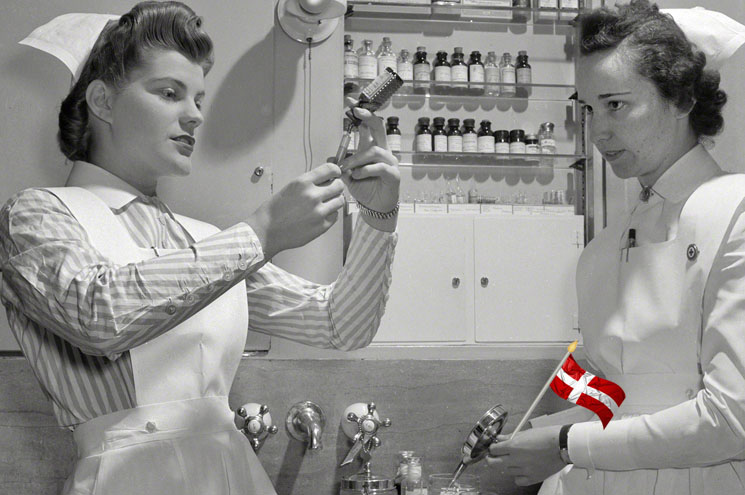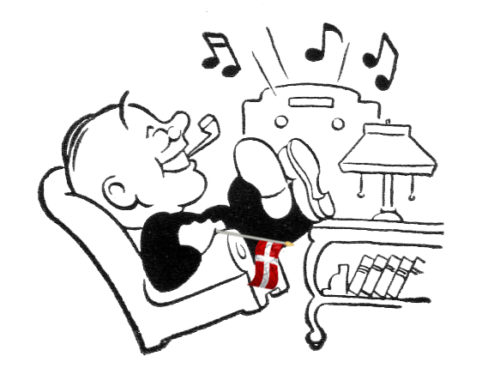I’ve just arrived back in Denmark after a couple of weeks in the U.S., and the night I got back, my cat bit me. This was not just a little affectionate peck – Fluffy used her sharp teeth, her fangs, to create four bleeding puncture wounds in my leg. I suppose it was partly my fault – I put a call on speakerphone. Fluffy doesn’t like speakerphone, because she can hear a person but she can’t see one, so she assumes I’m some evil magician who has put a person inside a little glowing box. And she bites me.
So I was bleeding, and I did what I did the last time she bit me – which was a couple of months ago, the last time I used speakerphone. I called 1813, the Danish government’s non-emergency line for off-hour medical situations.
I waited about five minutes for a nurse to take the call, and she asked me some questions about the size and location of the bite, and whether or not I’d had a tetanus shot recently. I hadn’t, so she made an appointment for me at the local emergency room for about an hour later.
Robot check-in
When I got to the emergency room, there was no human being to greet me – just a very tall robot with a scanner. I scanned my yellow Danish health card. The machine said ‘beep’ and automatically put me in line according to the seriousness of my injury. (Which was not all that serious.)
I waited a half hour or so. Then I was seen by Nurse Andrea, who examined the bite and then referred me to handsome Dr. Rasmus.
Handsome Dr. Rasmus was the highlight of the evening. He had a great bedside manner, and gave me a shot and enough penicillin to last the evening. Then he sent me home with a prescription so I could go to the pharmacy to pick up more penicillin, just in case Fluffy had some bacteria on her small teeth. And that was that, until I use speakerphone again.
Health care quirks
This type of situation is when the Danish health care system works well. There are no forms to fill out, no insurance to hassle with, and no payment of any kind. In general, the Danish system is excellent with things that have to be handled right away. They’re quick and efficient. I’ve even heard of tourists who have, say, broken an ankle in Copenhagen and come back raving about the health care they received.
And, of course, it’s all tax-funded. (I hate it when people say Danish health care is ‘free.’ I pay some very serious taxes for all this ‘free’ stuff.)
But the Danish health care system has some quirks. First of all, if something doesn’t have to be handled right away, it isn’t. There used to be long waiting lists for cancer treatment, which have mostly been eliminated, but if you’re looking for knee surgery or a cataract operation or any other treatment that doesn’t require instant action, it can take a while.
Your own doctor has to send you to a specialist, and getting an appointment there can take three or six months, and then after that you’ll have to wait for an appointment for surgery. (A convenient website lets you know the waiting time at various hospitals.) When you do get an appointment, the Danish health service picks the time and date, and you’d better be there. If you have other plans, they’ll give your time to someone else on the list.
Another quirk is that the Danes are not really into active treatment of small illnesses. For colds and the flu, they like hot tea and hot rum, staying home from work, and not really anything else. So, if there’s something special from your home country that you find comforting when you get sick, I recommend you bring it with you.
Doctors in Denmark are also very reluctant to prescribe any kind of antibiotic, sleep medication, or prescription painkiller. They generally just tell you to take ordinary ibuprofen or Panadol that you can get at the supermarket. I had a C-section when I gave birth to my daughter, and that’s what I got – ibuprofen and Panadol.
You can ask your doctor for something stronger, but there’s no guarantee you’re going to get it, and if you do, you’re going to have to pay for it yourself. (Don’t ever order medicine through the mail from other countries; this is considered ‘drug smuggling’ and if the stuff is caught at customs you will get a Danish police record and a fine.)
Dentistry is not covered by the public health system, at least for adults, and it’s so expensive in Denmark that it’s very common for people to go to on a ‘dental vacation’ to Poland or Hungary. Probably not for an annual check-up, but if you need major dental work, it is sometimes actually cheaper for you and a friend to fly to Krakow or Budapest or even Prague and get your teeth done, and even work in a little sightseeing.
Buy Kay’s books about Denmark on Amazon, Saxo, Google Books, Apple Books, Barnes & Noble Nook, or via our webshop.
Image mashup copyright Kay Xander Mellish 2025
Read also:
Inequality in Denmark: Private Schools and Migrants Who Sleep in Sandboxes





